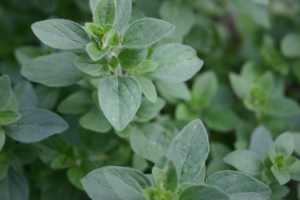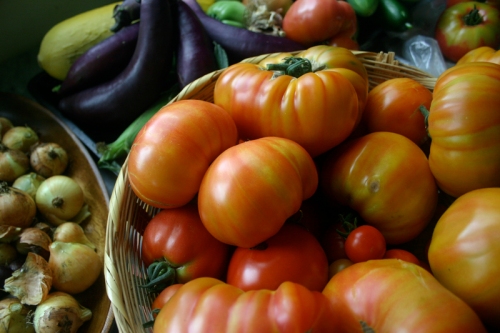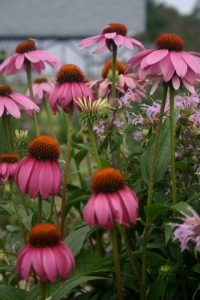By Orna Izakson
There are two ways to start your first garden. The long way is to go to every garden center in walking, biking, driving distance, order and pore over every seed and plant catalog in existence, and spend a lot of time reading in the library or at the bookstore before getting a smidge of dirt on your hands.
The short way is to just get outside and get dirt on your hands.
I’m a long-time gardener and avid reader and noodler, so I took the long way. Then one day two friends dug a big oregano and some strawberries out of their garden for me and said “these need to be in the ground by tomorrow.” And that’s what got me out of my books and into the dirt.
By all means, order and read every catalog, and borrow or buy lots of books. Each contains a ton of information that will otherwise take you a long time to learn. But in the end you can’t garden from a book — you have to garden with your knees in the soil.
So here’s a step-by-step plan for getting your first garden going, the easy way.

Origanum vulgare (oregano)
Access to sun: Most of what you’re likely to want to grow at first will be easy food crops that live for only one season, plants like peas, beans, tomatoes, potatoes and greens. All of those like as much sun as they can get. So look around the area you plan to plant and see where you get the most sun. Ideally you’ll have a spot with no big, tall, shady trees or buildings directly to the south, and that gets unshaded sun for most of the day.
Access to water: It should also be within reach of a hose, or you’ll spend a lot of muscle power hauling water around.
Access to soil: Your site should be dirt or grass, not gravel or pavement. If you’re worried about toxics in your soil, get it tested. Many plants will pull nasty chemicals out of the soil; that’s great for the soil, but you probably don’t want to eat them. If your spot is grassy, try piling flattened cardboard boxes or wet newspaper on it as soon as you know you want a garden; that will help kill the grass and make spring digging easier.
2. Decide what you want to grow
For your first garden, look for easy choices first. Some of the easiest plants to grow are herbs, peas, lettuce, beans, summer squashes like zucchini, tomatoes and potatoes. You might want to wait to grow foods like broccoli, melons and peppers until you’ve had more time to feed your soil and get some experience. Catalogs and garden centers will give you lots of choices — purple string beans, red speckled lettuce, black zucchini, yellow beets. The catalogs will give you basic information about when and how to plant. For instance, lettuce seeds don’t want to be buried under the soil, just sprinkled on top where they get sunlight. Peas, on the other hand, want to go an inch or two under the ground. Potatoes like to start in a trench and have soil mounded up around to support — but not cover — their growing leaves. Some beans (like peas) grow in bushes, but others need to climb strings or fences or tipi poles made of tree branches or bamboo or even 2x4s. All of that is in the catalogs.
3. Buy what you want to grow
Order the seeds or buy plants at the nursery (click here for local resources.) When you’re just getting started, you can buy seeds for things like potatoes (you’ll be buying small planting potatoes), kale, lettuce, beans and peas, but get herbs, tomatoes and squashes as plants. (You can get the lettuces and kale and beans as plants, too, if you prefer.)
Be careful not to bring home too much! You’ll need to leave more space between most plants than you think, especially when you first get them home as babies. Your plants will be happier with some space for light and air between them, and so will you.
While you’re there, buy enough compost to cover your whole new garden area two to four inches deep.
4. Prepare the garden bed
Now that you’ve got the seeds or the plants, they’ll be calling to you day and night to give them a home. Some of them may survive in pots, but many of them will die! Isn’t that incentive to get digging?
If you’ve still got grass, now’s the time to dig it up. Use a shovel or a spade to slice under the grass, through the tough, thatchy layer of roots. It sometimes comes off in pretty clean slices. Shake good soil off the roots, and put the grass (stems and roots) into a separate compost area.
Loosen up the grass-free soil about 12 inches down. Cover with a few inches of compost and mix it all together.
If you’re feeling adventurous, you can buy a kit to test the acidity of your soil, or its nutrient levels, and then buy products like lime (to reduce acidity) or organic fertilizers to make up for any deficiencies. Your plants will grow better if they have all the things they need. But basically plants want to live, and will likely give you some food as long as they have some nutrients from the compost and enough water.
5. Plant!
Now it’s time to put those babies in the ground!
If you’re growing from seeds, follow the directions in the catalog or on the packets, paying attention to what you can plant when. For instance, peas want to go into the ground early in the spring – February or even late January in Portland. Potatoes like wet weather and also go in early. But beans and squash will only rot in the soil if you plant them that soon. Wait until the days are generally pretty warm before putting them in the ground.
If you’re transplanting babies from the nursery, follow these directions: Prepare a hole about the size of the pot they came in. Gently tip the pot over onto your hand to remove the plant – never pull it out by the stem! Then place the plant in the hole, filling around it with soil to a point just a little bit further up the stem than the soil was in the pot. Ideally, the final soil level around the plant will be a little bit lower than the surrounding soil surface; in other words, the plant will be in a little bit of a depression. That will help water flow toward the roots.
You can also conserve water by mulching, which means piling loose organic stuff like leaves, grass clippings or straw (not hay, which has seeds) around the base of your plant. That keeps water from evaporating as quickly in the summer. You can get very fancy with mulches, using things like filbert shells or cocoa bean hulls, but it’s not necessary. Avoid wood chips, which can be made from wood treated with arsenic, and sawdust, which uses up a lot of nutrients and oxygen as it decomposes, stealing those goodies from your plants.
6. Dont forget to water!
Obviously watering isn’t a big concern during our rainy months. But when it gets dry out, you’ll want to water pretty much every day. Your plants will get the most from your efforts if you water in the evening, leaving them the cool night to soak up the moisture. Daytime water evaporates much more quickly, giving the plants less bang for your buck. Some plants, like tomatoes, prefer not to have wet leaves overnight. The best thing you can do for all your plants is to get a drip or soaker hose, which winds among your plants and delivers water directly to the top of the soil.
How much water is a question that’s hard to answer. Peas and potatoes like a lot of water. Tomatoes may ripen faster if you give them less. Again, garden catalogs will give you some sense of what you need, but the best thing is to ask a knowledgeable friend, or to just learn from trial and error. If the plants look really wilted in the early morning (not just at the end of a hot day), they probably need more water than you’re giving them.
Resources
Staffers at most nurseries and seed companies are fonts of garden wisdom. But this guide was prepared specifically because they can get swamped when the sun starts coming out, bringing all the new gardeners with it.
Ready to learn more? Follow these links to some favorite books, and seed companies and nurseries for your further education. If you’d like more structured teaching, check out these educational resources. And browse around this site, because, like a garden, it’s always sprouting something!

August bounty from the Newforest Institute gardens
 welcome to gardenmedicine, home to information about creating beautiful landscapes that feed your eyes, your body and your soul. on these pages i’ll discuss growing and using specific medicinal plants, shrubs that can help your garden be more productive, herbs that feed the pollinators on which we depend, and flowers and weeds that help keep you healthy.
welcome to gardenmedicine, home to information about creating beautiful landscapes that feed your eyes, your body and your soul. on these pages i’ll discuss growing and using specific medicinal plants, shrubs that can help your garden be more productive, herbs that feed the pollinators on which we depend, and flowers and weeds that help keep you healthy.







